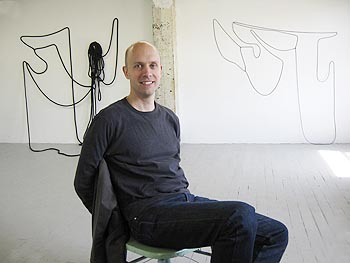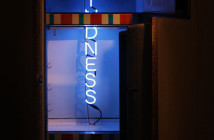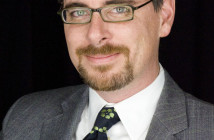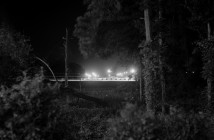INTERVIEW WITH JOSEPH CARROLL
Jess T. Dugan: To provide a background for this conversation, can you speak about how you came to work at the Bernard Toale Gallery as well as a brief history of the gallery itself?
Joseph Carroll: I joined Bernard Toale Gallery in May of 2003, just after Bernie reopened his gallery in its current space. Bernie’s first gallery was on Newbury Street, one floor below Howard Yezerski’s gallery and across the street from Barbara Krakow. I used to visit their spaces before I had any thoughts about being in the business myself. In 2000, after I finished my MA at NYU, I started working with Dan Elias in his gallery in Allston. I worked with Dan for three years and had a great time. Dan’s space was basically in Bernie’s backyard, really right around the corner from Bernie’s house in Allston. I would see Bernie in the neighborhood and then also at First Fridays in the South End. In April of 2003, I was on the phone with Beth Kantrowitz of Allston Skirt Gallery and she mentioned that Bernie’s previous director was leaving. It was time for me to make a change so I called Bernie up and asked if he would like to talk about working together. His decision worked out well for both of us.
JTD: There have been a lot of rumors circulating about galleries closing in Boston, and the Bernard Toale Gallery is one that has been receiving a lot of attention. Can you talk about the reasons the gallery is closing as well as your plans for your new space?
JC: Bernie and I have been talking about how to go forward with the gallery over the past three years. So for us, the “closing” of Bernard Toale Gallery isn’t such big news. Although technically BTG is closing June 28th, Bernie and I will both still be at 450 Harrison Avenue doing much of what we each have been doing over the last 5 years, just under different names. The changes at BTG reflect the direction the gallery has been moving in for a while now – Bernie has been working more with clients and a few artists on particular projects, and I have been working closely with artists on exhibitions and running the gallery. So, our new ventures will just allow each of us to focus on what we want to do. Luckily, the current gallery can be easily divided it into two autonomous spaces allowing us both to keep our beautiful rooms.
JTD: What motivated you to start your own gallery, and what compels you to exhibit the work of artists as opposed to making art yourself?
JC: I really enjoy working with artists and running a gallery. After working for eight years in two wonderful places, starting a place of my own is just the logical next step. Although I’m looking forward to my space reflecting my personal taste and vision, working with a variety of artists allows me to share in a multiplicity of ideas and media. I think that is difficult to do as an artist if not antithetical to the artist’s responsibility.
JTD: Do you have a name for your new gallery?
JC: Naming a business, and I think especially a gallery, is a fun challenge. Many galleries take on the name and the personality of their owners. The whole cult of personality thing just doesn’t suit me. Despite the fact that most of the galleries in Boston are one step above mom and pop operations, the names often have a sense of self-seriousness reinforced by the hushed atmosphere of the spaces themselves. I want a space that is comfortable and inviting, where ideas are bandied about and discussions aren’t always polite, and where I can roll up my sleeves and get to work. We’ll see what kind of name I can come up with.
JTD: What is your time frame for the opening of the gallery? Do you have any plans for the first show?
JC: The gallery will open in September. The schedule is pretty much set with a few commitments still to confirm. I think you can count on seeing some of the artists I’ve been working with in the past as well as some new faces.
JTD: You are highly regarded by artists and art professionals as one of the key players in the contemporary art scene, partially because you are very knowledgeable about many different areas and types of art. In your new space, do you have a specific theme or goal? What kinds of artists do you plan to show?
JC: If I have a theme or a goal I guess it is to do the best shows I possibly can this first year and to be successful enough to do it again another year. Over the past months I have been asked if I will be a photography gallery, or will I focus on works on paper, or exhibit only Boston artists – my answer to those kinds of questions is that I want the freedom to show the artists and work that interests me, regardless of media or the artist’s locality. As for the artists, I think you can categorize them as deeply committed to their practice, involved in visual culture, high and low, old and new, and aware of how their work fits within the context of the art world and the world at large. I’m drawn to work that is both serious and playful, and that balances smarts and visual appeal. It sounds like I’m writing a personal ad.
JTD: The Boston Drawing Project is a unique concept for a gallery and has attracted hundreds of emerging artists. Do you plan to take the Drawing Project and its artists with you to your new space?
JC: Most emphatically yes, the Drawing Project will continue on in the new gallery. I have learned so much from the artists who bring in their work for review and I look forward to seeing what comes in the door next fall. My goal for the fall is to have a stronger web presence for the Project with more images and information for all participating artists.
JTD: When curating work, how do you decide what to exhibit? Do you consider the current trends in the art world or trends throughout art history, or do you judge the work purely on its own terms?
JC: There are lots of factors that go into deciding what to show. I think the most important one is to simply like the work. Then how an exhibition furthers the work and what will it add to the conversation of the gallery. After that, it’s a balance between program, audience, and logistics. If you go to shows, read the journals and reviews, it’s pretty hard not to see work within the context of trends and history. For me that context adds richness to good work and I’m not sure why an artist wouldn’t want their work to be considered in a broader context. Art does need to be strong enough on its own, and context does change, but I think part of my job and that of the artists’ is to place the work within a context.
JTD: Why did you choose to stay in the same physical location as the current Bernard Toale Gallery? What changes do you plan to make to the space? Do you think the location will cause any confusion, or will it be clear that the gallery has changed?
JC: BTG is such a great space, it would be really hard to leave it. The artists love the space and they, and I, are identified with the current space. I think starting up someplace else would produce more confusion for people. Bernie and I are going to divide the gallery and I will make a few subtle changes to the present layout. The Drawing Project will be relocated to my current work area, I will move to a new desk in the front of the gallery, and what is now Bernie’s office will become a flexible space for presenting work, video projections and longer term installation projects. If there is a little confusion when people visit the gallery next fall, and if people have to question where they are, that’s probably a good thing, too.
JTD: Several galleries are either closing or have recently closed. Do you think this is due to economics (as some have suspected), lack of interest in contemporary art in Boston (as others have suspected), or part of a natural cycle of the old moving out to make place for the new? What do you think this means for contemporary art in Boston?
JC: There hasn’t been much change in the Boston gallery scene for many years so we are probably due for a little shake up. It seems that every gallery in town is on the same lease cycle, the renewing of which is a natural time to consider continuing on or not. That has played a larger roll in the current changes than the economy. Like Bernie and I, many gallerists have been considering how to go forward well before the current economic downturn. What has been amazing is the amount of press that has come out of a few changes in the gallery scene. I think the concern in the press says a lot about the level of interest in galleries and the support for contemporary art in Boston. We just have to work harder to focus that attention on our exhibitions once the sense of crisis is over.
JTD: In your experience, has the current economy affected the success of either individual artists or the purchase of art through galleries? Do you think the art market is heavily dependant upon the economy, or does it stand somewhat on its own?
JC: Did you read about the results of the Sotheby’s auction on the May 14th? A Francis Bacon triptych from 1976 sold for $86 million dollars! I don’t think the art market is independent of the larger economy but they don’t appear to be synchronized at the moment. I don’t think Bush’s tax rebate was fueling the auction sales. I think the answer to your question is yes, and yes. At a certain level, like the recent auctions show, the market is independent of the general economy. At the lower end, I would say they are more closely linked. In terms of the effects on individual artists, economic factors do play a role in sales but so do other factors and trends.
JTD: It seems that art fairs are all the rage. There has been some debate about what effect this has both on galleries and artists. How do you feel about art fairs, and do you plan on representing your new gallery and artists at fairs?
JC: I think art fair fatigue is all the rage. I heard many conversations over the past year about the fairs people weren’t going to. I think art fairs can benefit galleries and artists but, for a small gallery, the trick is how to stand out from the crowd. Remember, there were 18 fairs in Miami last December. I think of fairs as one of several advertising options. I will certainly consider them but I do question whether they are the best way to support and promote artists.
JTD: Over the years, you must have seen the work of thousands of artists. What advice do you have to the young or emerging artist who is trying to approach a gallery?
JC: First off, young artists should understand that finding gallery support is a process, one that takes time and a bit of work. It is important for artists to have a sense of what they want out of their work and the kind of venue and goals the work suggests – i.e. a commercial space versus a non-profit, the importance of sales, the exhibition context, are commissions more likely for the work, and how important are reviews and publications etc. If a gallery is the right outlet for the work, then get to know the gallery before approaching them, meet the staff, and learn about gallery artists. Sometimes it is easier to become friends with one of the gallery’s artists and that can lead to an artist’s recommendation to the gallery, which is more likely to get your work reviewed. Be sure to present the work in the best possible way with all the information that a reader will need to understand what is being presented. Be diligent without becoming a pest and respect the gallerist’s option to not be engaged by the work. If they do express interest, then follow up and keep them informed.
JTD: What is most exciting for you about this process, and what are you most looking forward to?
JC: Starting my own gallery is a great opportunity to think about questions like these and about what I want my space to be. I’m incredibly fortunate to have worked in two great spaces and to have enjoyed a large amount of freedom at each. It may sound odd, but I am enjoying working with graphic designers, business planners, lawyers and accountants and finding out lots of information outside of my daily routine. That has been, and is still, a nice part of this process. But the reason for all of these efforts is to be able to continue working with artists and helping realize their visions. I have a great group of artists to work with and I continue to be excited by what they can do.
- Joseph Carroll
All images are courtesy of the author.





